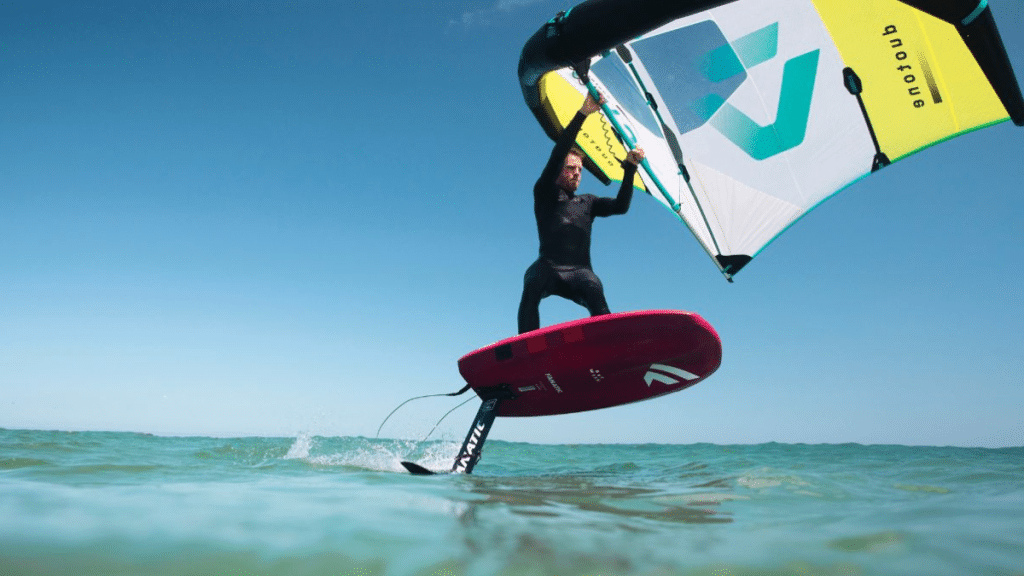The feeling of flying above water while harnessing wind power has captured the hearts of water sport fans worldwide. In 2025, wing-foiling leads the pack as the fastest growing wind sport. While kiteboarding holds strong with its Olympic status, wing-foiling offers a simpler path for most new riders. Let’s compare these two wind sports to help you choose the right one for your goals.
Snapshot of Each Sport in 2025
Kiteboarding uses a large kite to pull a rider across water on a board. The sport made its Olympic debut in Paris 2024, bringing it global attention. Riders control the kite with a bar connected to lines, while standing on either a twin-tip or directional board.
Wing-foiling combines a hand-held inflatable wing with a hydrofoil board. The wing lacks attachment lines, making it easier to control. The hydrofoil lifts the board above water, creating a floating sensation. The sport has seen massive growth, with experts predicting a 15% yearly market increase through 2033.
Learning Curve Showdown
Hours to First Rides
Wing-foiling basics can be picked up in 5-30 hours, depending on your board sports background. Most riders can stay up on the foil and cruise after a week of practice. The learning path is more even, with steady progress after mastering the basic stance.
Kiteboarding requires 6-12 hours of formal lessons plus extra practice time. The kite control skills need focused learning before you can safely ride. Weather, teaching quality, and your athletic skills affect how fast you learn.
Skills Complexity
Wing-foiling has fewer moving parts. You hold the wing directly with your hands and can drop it any time. No lines means no tangles. The wing depowers instantly when you let go, making it safer for beginners.
Kiteboarding involves learning the “wind window” concept, managing four or five lines, using a control bar, and hooking into a harness. The extra steps mean more things to master before your first real ride.
Safety & Accessibility
Wing-foiling wins on safety for most new riders. With no lines to get wrapped around you or others, the risk drops. When you fall, simply let go of the wing and it stops pulling. Most wings float, making water starts easier.
Kiteboarding requires more open space due to the lines that stretch 20-25 meters from rider to kite. This limits where you can ride. Wing-foilers can launch from smaller beaches, lakes, and harbors where kiters might not fit.
Weather needs differ too. Wing-foiling works in a wider range of wind speeds, making it more useful in places with changing conditions.
Gear, Cost & Portability
A complete wing-foiling setup includes the wing, board with hydrofoil, pump, leash, and wetsuit. Starter packages have become popular in 2025, with many shops offering all-in-one kits. Expect to spend $2,000-3,500 for new gear, though used equipment markets are growing.
Kiteboarding requires a kite, control bar, lines, board, harness, pump, and safety gear. New kite setups cost about $2,500-4,000. The gear takes more space when packed and weighs more than wing-foil equipment.
Both sports offer ways to buy used gear, but wing-foil equipment holds value better due to high demand in 2025.
Performance & Progression
Kiteboarding still leads for big air and extreme tricks. The larger kites generate more power for jumps, and twin-tip boards handle rough water better. Advanced kiters can jump 10+ meters high and perform complex aerial moves.
Wing-foiling shines in versatility. The ability to ride in light winds (10-12 knots) extends your time on water. The hydrofoil’s efficiency means you can cruise further using less energy. Many riders can go downwind for miles, creating new adventure options.
Cross-sport benefits exist too. Wing-foilers often try downwind runs, wave riding, and pump-foiling (riding without wind power). The skills transfer well to other foil sports like surf foiling.
Where the Future Is Blowing
Major sailing events now include wing-foiling. SailGP partnered with Armstrong Foils for the 2025 season, bringing the sport to global audiences. World Sailing continues talks about Olympic inclusion after 2028.
Market data backs the trend. Wing-foil equipment sales grow at 15% yearly, while kiteboarding gear expands at 6.8%. Shops report that most new wind sport customers choose wings over kites in 2025.
The tech keeps improving. Lighter wings, more stable foils, and package deals make starting easier each year.
Decision Guide – Which Sport Suits You?
Choose wing-foiling if you:
- Want a quicker path to basic riding
- Value safety and simplicity
- Ride in spots with limited space
- Need gear that packs small for travel
- Enjoy light wind days
Pick kiteboarding if you:
- Dream of big jumps and aerial tricks
- Have time for a longer learning process
- Want to try the Olympic-recognized sport
- Prefer riding in waves and rough water
- Enjoy the community and established schools
For most new riders in 2025, wing-foiling offers the faster path to enjoyment. The average beginner rides competently within a month, compared to several months for kiteboarding.
Ready to Get Started?
The best way to decide is to try both sports. Many schools now offer taster sessions where you can feel the difference. Gear testing events happen regularly at popular beaches.
Wing-foiling’s growth means more lesson options than ever. Look for certified schools that provide all equipment. Start with a larger, stable board before moving to advanced foils.
If kiteboarding calls to you, seek IKO-certified instruction to ensure proper safety training. Never learn from YouTube alone—proper guidance makes all the difference.
Whichever you choose, both sports offer the unique joy of using wind to glide across water. The right choice depends on your goals, time, and local conditions. In 2025, the wind sport community welcomes you to join the ride.
